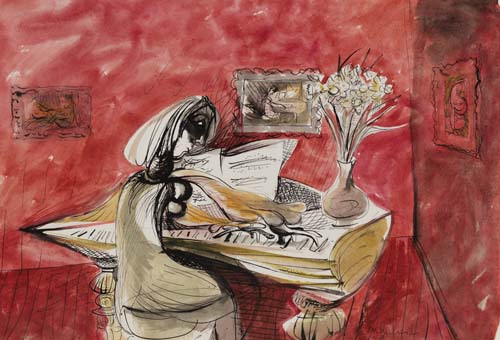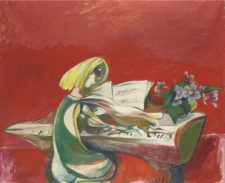
Ceri Richards
British, 1903-1971
The Pianist, 1944
watercolor and ink on paper
14 1/2 x 21 1/4 in.
SBMA, Gift of Wright S. Ludington
1947.13.8

Undated photo of Richards
POSTSCRIPT
A painting by Richards from the collection of the late Sir Colin and Lady Anderson sold by Christie's November 18, 2005 (see image below) is quite similar to the watercolor in the SBMA collection.
Description: The Pianist
signed and dated 'Ceri Richards 44' (upper right)
oil on canvas
28 x 34 in. (71 x 86.5 cm.)
Notes: Dating from 1944, the present work was painted four years after the subject matter of a female piano player within a domestic setting first appeared in Richards' work. It was to become a subject that he would explore compulsively throughout his career, painting a huge range of works depicting this subject matter. Richard often based these paintings of pianists on his observations of his daughters playing the piano. In the present work, the seated figure is bent over the piano in concentration and the movement of her hands over the keys is emphasized by her billowing white sleeves.
Mel Gooding comments, 'the artist's portrayal of musical rapture is in essence a recognition of the grace that art confers on those who acknowledge its power. Richards' own deep love and knowledge of music, as both executant and listener, inform his treatment of the subject of music in a room, just as his vocation as a painter motivated what was to be a sustained creative engagement with subjects drawn from everyday life... The enclosed and crowded world of these paintings is rich in signs and indications... They stand for a life enjoyed, even in its way luxurious, in the sense that they are things the need for which is a matter of feeling and spirit; they are beautiful things, the accoutrements of a civilized life in a sheltered space. In the house on Wandsworth Common, Richards was himself surrounded by the female family of his wife and two daughters, and by objects familiar and valued. These paintings with their reverberant colourism, their decorative arabesque vigor, their fullness of good things, sweet sound and floral perfumes, reflect that contained domesticity. They are deeply tender in feeling, but detached in mood' (Ceri Richards, Moffat, 2002, pp. 90, 97).

From the Collection of the late Sir Colin and Lady Anderson sold by Christie's November 18, 2005
COMMENTS
British painter, printmaker, designer, and maker of reliefs, born into a Welsh-speaking family. From 1924 he spent most of his life in London, but he remained close to his Welsh roots. His output was many-sided, and Sir John Rothenstein writes that ‘Richards's work is widely admired but there is little consensus of opinion about its essential character.’ In 1936 he took part in the International Surrealist Exhibition in London and he said that Surrealism ‘helped me to be aware of the mystery, even the “unreality”, of ordinary things’. At this time he was also strongly influenced by Picasso, notably in a series of semi-abstract relief constructions begun in 1933. After the Second World War his painting drew inspiration from the large exhibition of Picasso and Matisse at the Victoria and Albert Museum in 1945. His best-known works include the Cathédrale engloutie series, based on a Debussy prelude (which Richards used to play on the piano)
- Ceri Richards, in The Oxford Dictionary of Art and Artists
SBMA CURATORIAL LABELS
Welsh born Richards studied at Swansea College of Art before moving to London, where he continued his studies at the Royal College. He was attracted to surrealism, developing a strongly personal style, imbued with Celtic lyricism, frequently referenced to musical compositions.
- British Modernism from Whistler to WWII, 2016
Characteristic of Richards’ style and subject matter in mid-career, these two drawings show his late “fauve” decorative manner, although without as great an indebtedness to Matisse as is often evident in his art. Himself an accomplished pianist, Richards made the theme of the pianist his own, repeating it in numerous variations for more than twenty years. The intense red and the urgent spontaneity of the draftsmanship give to what is a basically tranquil, intimate scene, a vitality almost equal to the energy of the figures throwing coconuts in the amusement park setting of Coconut Shy; it is as if Richards experienced all living as a kind of happy frenzy. The mirror image on the wall before the eyes of the pianist hints also at the kind of playfulness which is over in Coconut Shy.
- Past exhibition label
